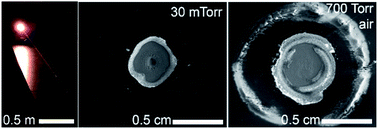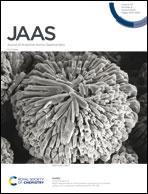The role of ambient gas confinement, plasma chemistry, and focusing conditions on emission features of femtosecond laser-produced plasmas
Abstract
Ultrafast laser ablation coupled with optical emission spectroscopy is currently under development for standoff detection of elements and their isotopes for a wide range of application areas. In this work, we explore the role of ambient air pressure during the interaction of an ultrafast laser beam with two metallic targets (brass and uranium) with significantly different oxygen gas-phase reactivity. Plasma plumes were generated by focusing ∼800 nm, ∼35 fs pulses from an ultrafast laser system using a long focal length lens (f = 1 m). Two-dimensional spectral imaging was performed over the pressure range of 30 mTorr to 700 Torr air to evaluate emission dynamics, plasma chemistry, signal-to-background ratio, and characteristic parameters (i.e. excitation temperature, electron density). An increase in ambient air pressure during ultrafast laser ablation leads to plume confinement and subsequent changes in the emission dynamics due to plasma chemistry as well as changes in plasma generation conditions (i.e. focused fs laser ablation versus filament ablation). Ablation crater morphologies were also investigated via scanning electron microscopy. Results indicate atomic emission intensity and signal-to-background ratios peak at moderate pressure levels (∼50–100 Torr air) for both targets studied, although plasma chemistry influences uranium emission signatures. The emission features of the uranium plasma at pressures ≥10 Torr showed the presence of oxide molecules. We also find filament ablation leads to wider, more shallow craters compared to focused laser ablation. Our study provides unique insight into the interplay between plume dynamics, confinement, and plasma chemistry of fs laser-produced plasmas and how these phenomena evolve with changing ambient air pressure.



 Please wait while we load your content...
Please wait while we load your content...
